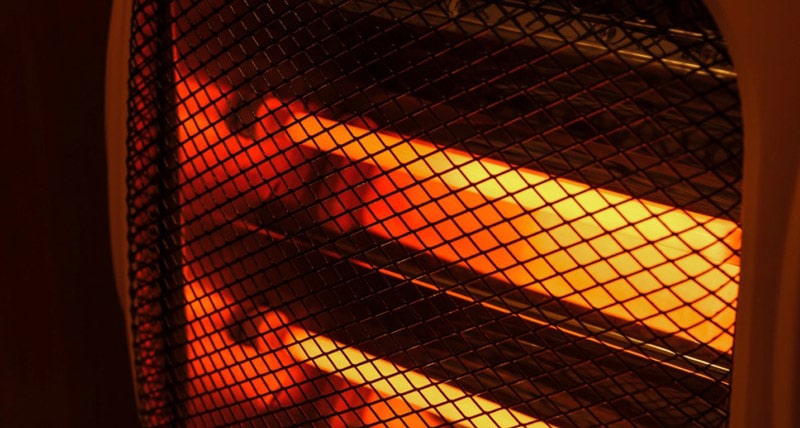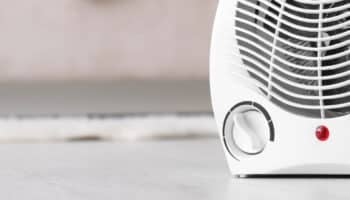There’s nothing worse than it being super cold out, only to find your space heater isn’t working anymore.
Thankfully, since space heaters are common appliances they also have common solutions.
If your space heater isn’t working, make sure to check it with a different wall outlet, check it’s power cord for damage, any tilt switches to see if they’re triggering, the space heater’s thermostat (if digital), and check to see if the heating element might be a dud.
That’s the short answer, but there’s more to it than that. For each of those fixes above (and more), I’ve included a more detailed explanation and guide to checking and fixing each one.
If that sounds good, let’s dive in.
Troubleshooting A Broken Space Heater
Before we delve into the specifics, it’s important that we clarify what’s wrong. Is your unit not turning on? Or does it look fine, but won’t heat up?
To help, I’ve broken the potential causes into two different categories – which we’ll go through in detail below:
Space Heater Won’t Turn On
- A faulty wall outlet
- A damaged power cord
- A malfunctioning tilt switch
- A blown thermal fuse
Space Heater Won’t Heat Up
- A broken thermostat
- A bad heating element

6 Reasons Why Your Space Heater Isn’t Working (With Fixes)
Okay, now that we’re clear on what belongs where, we can go deeper into each potential culprit, and find the right answer.
#1 A Faulty Wall Outlet
Before thinking anything internal is wrong with your space heater, we ought to look at one of the most common external culprits: the wall outlet.
This can be a little tricky to diagnose, as any malfunction could be mistaken for short–circuiting or overheating. You might think this isn’t a big deal, but trust me, it definitely is.
Depending on the severity of the damage to your outlet, it could be supplying no electricity, or doing so intermittently. The latter is much more concerning than the former, as it can quickly lead to causing permanent damage to your space heater.
As soon as you suspect this to be the source of the issue, please stop using your appliance.
Solution: Try using a different outlet.
Unplug your space heater and let it cool down completely. Once you have done that, take it to a different section of the house and plug it back into a different outlet. Preferably, as far removed from the one you normally use, as possible.
If your space heater is working again after doing this, mystery solved.
Want a DIY challenge, and own a multimeter? You can use it to test the suspicious outlet for continuity.
This is optional, but strongly encouraged, as a faulty outlet could be the first symptom of a greater malfunction in your home’s electrical layout.
#2 A Damaged Power Cord
Assuming your wall outlet is unscathed, we can safely move on to the next chain in the power supply link: The power cord.
This cable may seem thick and sturdy on the outside, but inside its rubber housing, there are several smaller cables that make it up and transport electricity. While these are not awfully fragile, they’re not indestructible either.
Seemingly unimportant bad habits, such as keeping your cord tangled, stored away improperly, or pressed against an object in a weird angle, are more than enough to do it in.
Just as it happens with your wall outlet, depending on the severity of the damage to this component, it could be supplying no electricity or doing so intermittently, which could cause serious problems.
So, if your space heater is not working, there’s a very good chance that you need to replace the power cord.
Solution: If you have a spare cord, use it.
I don’t expect you to have another cable lying around, but on the off chance that you do, using it to see whether your current cord is faulty can save you both time, and money.
Just make sure it meets the same amperage and voltage requirements as the broken one.
If you don’t have another cable for testing, that’s fine too. You can find a replacement at any online marketplace by Google searching your space heater’s make and model.
#3 A Malfunctioning Tilt Switch
It’s amazing how such a small component can protect you so well.
In case you’re not familiar with what a tilt switch is, let me briefly explain. This part is responsible for detecting when your space heater is about to fall over. Once this component detects excessive inclination, it kills electricity or gas supply in order to prevent the incident from starting a fire.
When it works normally, it should not be activated unless your appliance is about to tip over. However, any malfunction could trick it into thinking that your space heater is constantly about to fall, thus rendering it incapable of turning on.
This is not an awfully common occurrence, but it’s been known to happen.
Solution: Experiencing this malfunction does not necessarily mean that your tilt switch is done for. Sometimes, it might just be partially disconnected.
Please follow these steps to access it:
- Carefully unplug the appliance, and let it cool down
- Turn it around, and undo the screws at the back to remove the outer panel wall
- Expose your unit’s guts, and locate your tilt switch
- Gain comfortable access to the part, and inspect it
- Carefully reconnect or solder back any loose wires
- Test the switch for continuity
Should you get null readings on the meter, the part is dead, and needs to be replaced.
#4 A Blown Thermal Fuse
A blown fuse is not necessarily bad news
Without this component, your space heater would be at the mercy of overheating.
You’ve probably heard about fuses in the past. Whenever there’s a massive blackout, these normally “blow” to protect your home’s wiring. This same principle applies to thermal fuses, but, as their name suggests, they’re designed to counteract the effects of excessive temperatures.
Right now, you’re likely thinking, “I didn’t know space heaters could overheat”, and I get it, it’s completely counterintuitive.
When operating normally, your space heater should never overheat. But as you’ve learned in the points above, factors, such as a faulty wall outlet or a damaged power cord, can make this issue manifest itself.
If your space heater is not working, and you suspect it has overheated severely in the past, there’s a very good chance that your thermal fuse has blown.
Solution: Please follow the steps from the previous point to access your appliance’s guts and locate the thermal switch.
Repeat the same continuity test with your multimeter to determine whether the component is, in fact, dead.
If it is, you can easily buy a replacement from either your nearest hardware store, or your manufacturer.
#5 A Broken Thermostat
Have you ever wondered how your space heater goes about regulating its internal temperature?
If you have, the answer is simple. By using its thermostat.
This part is responsible for both measuring and regulating the internal temperature of your space heater. When it works normally, you should have full control over the unit. But when it malfunctions, you might find yourself owning an unresponsive appliance.
If your thermostat is faulty, it could be getting inaccurate temperature readings, tricking it into believing it’s overheating, when, in fact, it is not.
And since most space heaters have auto deactivation mechanisms to prevent this from happening, your machine won’t work, regardless of what you try.
Solution: Follow the steps from point #4 to gain comfortable access to your thermostat.
Once you have done that, repeat the continuity testing process and determine whether the part is still viable.
#6 A Bad Heating Element
Make sure your heating element is not causing overheating
Last, but definitely not least, is the possibility of a bad heating element.
This component is what allows your space heater to provide you with heat. Without it, you would just be stuck with a cold and expensive doorstop.
Your heating element works by transforming the electrical energy drawn from your wall outlet, into heat energy, thus increasing your living spaces’ temperature.
In most cases, a faulty heating element won’t generate heat, but sometimes, it can generate too much and cause overheating, prompting the unit’s safety mechanisms to kick in.
Solution: You know the drill, follow the steps from point #4, and test, test, test.
How to Reset a Space Heater?
I’d be remiss not to tell you about this. Sometimes there’s nothing wrong with your space heater other than the fact that it needs to be reset.
Now and then, any kind of electrical fault could cause the appliance to function strangely. Here’s how you can fix that.
Depending on your specific case and model, your space heater might have a dedicated reset button. If so, hold it down for about 10 seconds, and then wait for a minute or so. It should reset on its own.
Assuming your model does not have this button, you can always unplug it from the wall outlet, wait a couple of minutes, and then plug it back in. I know you’ve likely tried this, but it’s worth including for any readers who haven’t!
Conclusion
To have your space heater stop working, can be a nightmare. Whether your appliance is not turning on or not heating up, one thing’s for sure. You’re stuck with a useless machine until you figure out the source of the malfunction.
Fortunately, as I hope you’ve learned in this piece, addressing most of the causes behind this situation is simple and quick.
More often than not, checking your wall outlet, and replacing one or two misbehaving components, is all it takes to get your space heater back to its former glory.
Thank you so much for sticking with me all the way to the end. If you found this article helpful, why not become an expert in the subject through our other incredible resources below?
Stay warm and cozy!







